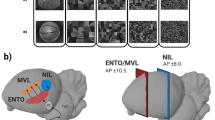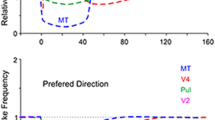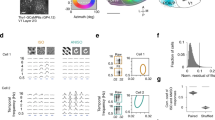Abstract
Responsiveness to slits and pattern stimuli was quantified in a total of 68 cells sampled in the posterior extreme of the lateral suprasylvian (PS) cortex as response indices. The cells were studied in relationship to their locations in several subareas of the PS cortex, including areas 19 (n=15) and 21a (n=32) and the posteromedial lateral suprasylvian cortex (PMLS; n=21). These subareas were identified based on retrograde labelling from area 17 and also supplemented with photic responsiveness. This analysis revealed that each cortical area contains cells expressing different combinations of stimulus features. Area 19 contained two major groups of cells: (1) those with strong end-stop selectivity combined with moderate orientation or direction selectivity, and (2) those with weak end-stop selectivity combined with strong orientation selectivity. The groups of cells with strong or moderate orientation selectivity showed a strong preference for stripe over visual noise patterns and relatively large modulatory responses to motion of individual stripes. The PMLS contained one major group of cells with strong end-stop and direction selectivities and with poor orientation selectivity. They also showed stronger preference for visual noise than cells in the other cortical areas and rather weak modulatory responses. Area 21a contained only one group of cells with strong orientation selectivity and length summation property rather than end-stop selectivity, and they also lacked direction selectivity. These cells exhibited a strong preference for stripe patterns and moderate or weak modulatory responses. Altogether, these findings indicate that each cortical area is specialized in expressing different stimulus features. The two groups of cells in area 19 may encode the position and motion of discontinuous visual elements such as corners and line ends and continuous elements such as lines and edges. PMLS cells may encode the motion of single elements or associated motion of multiple discontinuous elements such as textures and backgrounds. Area 21a cells may specifically encode the orientation of long, continuous elements such as lines and edges. In support of this view, two types of statistical analyses demonstrated that the combinations of the response properties expressed in individual PS cells are highly correlated with their locations in cortical areas and that the anatomical locations of individual PS cells are reliably predicted from the sets of response indices expressed in these cells.
Similar content being viewed by others
References
Bishop PO, Kozak W, Vakkur GJ (1962) Some quantitative aspects of the cat's eye: axis and plane of reference, visual field co-ordinates and optics. J Physiol (Lond) 163:466–502
Blakemore C, Zumbroich TJ (1987) Stimulus selectivity and functional organization in the lateral suprasylvian visual cortex of the cat. J Physiol (Lond) 389:569–604
Britten KH, Shadlen MN, Newesome WT, Movshon JA (1992) The analysis of visual motion: a comparison of neuronal and psychophysical performance. J Neurosci 12:4745–4765
Camarda R, Rizzolatti G (1976) Visual receptive fields in the lateral suprasylvian area (Clare-Bishop area) of the cat. Brain Res 101:427–443
Dreher B, Michalski A, Ho RH, Lee CWF, Burke W (1993) Processing of form and motion in area 21a of cat visual cortex. Vis Neurosci 10:93–115
Grabiel A, Berson D (1981) Families of related cortical areas in the extrastriate visual system. In: Woolsey CN (eds) Multiple visual areas (Cortical sensory organization, vol II) Humana, Clifton, NJ pp 103–118
Guido W, Tong L, Spear PD (1990) Afferent bases of spatial-frequency and temporal-frequency processing by neurons in the cat's posteromedial lateral suprasylvian cortex — effects of removing areas 17, 18, and 19. J Neurophysiol 64:1636–1651
Hamada T (1987) Neural response to the motion of textures in the lateral suprasylvian area of cats. Behav Brain Res 25:175–185
Hayashi C (1952) On the prediction of phenomena from qualitative data on the quantification of qualitative data from mathematico-statistical point of view. Ann Inst Stat Math 3:69–98
Heath CJ, Jones EG (1971) The anatomical organization of the suprasylvian gyrus of the cat. Ergeb Anat Entwicklungsgesch 45:4–64
Hubel DH, Wiesel TN (1965) Receptive fields and functional architecture in two non-striate visual areas (18 and 19) of the cat. J Neurophysiol 28:229–289
Hubel DH, Wiesel TN (1969) Visual area of the lateral suprasylvian gyrus (Clare-Bishop area) of the cat. J Physiol (Lond) 202:251–260
Kimura M, Shiida T, Tanaka K, Toyama K (1980) Three classes of area 19 cortical cells of the cat classified by their neuronal connectivity and photic responsiveness. Vision Res 20:69–77
Martin SG, Katz E, Schumer RA, Movshon JA (1990) Selectivity for orientation and direction of motion of single neurons in cat striate and extrastriate visual cortex. J Neurophysiol 63:1529–1543
Mizobe K, Toyama K (1989) Cortical and subcortical connectivity of area 21a of the cat. Biomed Res 10:397–410
Mizobe K, Itoi M, Kaihara T, Toyama K (1988) Neuronal responsiveness in area 21a of the cat. Brain Res 483:307–310
Morrone MC, Stefano M, Burr DC (1986) Spatial and temporal properties of neurons of the lateral suprasylvian cortex of the cat. J Neurophysiol 56:969–986
Niimi K, Matsuoka H Yamazaki Y, Katayama T (1983) Thalamic afferents to the anterior and middle suprasylvian gyri in the cat traced with horseradish peroxidase. J Hirnforsch 24:173–187
Palmer LA, Rosenquist A, Tusa RJ (1978) The retinotopic organization of lateral suprasylvian visual areas in the cat. J Comp Neurol 177:237–256
Pettigrew JD, Cooper ML, Blasdel GR (1979) Improved use of tapetal reflection for eye-position monitoring. Invest Ophthalmol Vis Sci 18:490–494
Rauschecker JP, Von Grunau MW, Poulin C (1987) Centrifugal organization of direction preferences in the cat's lateral suprasylvian visual cortex and its relation to flow field processing. J Neurosci 7:943–958
Sherk H (1986) Location and connections of visual cortical areas in the cat's suprasylvian sulcus. J Comp Neurol 247:1–31
Spear PD, Baumann TP (1975) Receptive field characteristics of single neurons in lateral suprasylvian area of the cat. J Neurophysiol 38:1403–1420
Symonds LL, Rosenquist AC (1984) Cortico-cortical connections among visual areas in the cat. J Comp Neurol 229:1–38
Tanaka K, Ohzawa I, Ramoa AS, Freeman RD (1987) Receptive field properties of cells in area 19 of the cat. Exp Brain Res 65:549–558
Toyama K, Kozasa T (1982) Responses of Clare-Bishop neurons to three dimensional movement of a light stimulus. Vision Res 22:571–574
Toyama K, Komatsu Y, Shibuki K (1984) Integration of retinal and motor signals of eye movement in the striate cortex cells of alert cat. J Neurophysiol 51:649–665
Toyama K, Komatsu Y, Kasai H, Fujii K, Umetani K (1985) Responsiveness of Clare-Bishop neurons to visual cues associated with motion of a visual stimulus in three-dimensional space. Vision Res 25:407–414
Toyama K, Komatsu Y, Kozasa T (1986a) The responsiveness of Clare-Bishop neurons to motion cues for motion stereopsis. Neurosci Res 4:83–109
Toyama K, Fujii K, Kasai H, Maeda K (1986b) The responsiveness of Clare-Bishop neurons to size cues for motion stereopsis. Neurosci Res 4:110–128
Toyama K, Fujii K, Umetani K (1990) Functional differentiation between the anterior and posterior Clare-Bishop cortex of the cat. Exp Brain Res 81:221–233
Tusa RJ, Palmer LA (1980) Retinotopic organization of areas 20 and 21 in the cat. J Comp Neurol 193:147–164
Tusa RJ, Palmer LA, Rosenquist AC (1981) Multiple cortical visual areas. Visual field topography in the cat. In: Woolsey CN (eds) Multiple visual areas. (Cortical sensory organization, vol 2) Humana, Clifton, NJ, pp 1–31
Updyke BV (1981) Multiple representations of the visual field. In: Woolsey CN (eds) Multiple visual areas. (Cortical sensory organization, vol 2) Humana, Clifton, NJ, pp 83–101
Updyke BV (1986) Retinotopic organization within the cat's posterior suprasylvian sulcus and gyrus. J Comp Neurol 246:265–280
Zumbroich TJ, Blakemore C (1987) Spatial and temporal selectivity in the suprasylvian visual cortex of the cat. J Neurosci 7:482–500
Author information
Authors and Affiliations
Rights and permissions
About this article
Cite this article
Toyama, K., Mizobe, K., Akase, E. et al. Neuronal responsiveness in areas 19 and 21a, and the posteromedial lateral suprasylvian cortex of the cat. Exp Brain Res 99, 289–301 (1994). https://doi.org/10.1007/BF00239595
Received:
Accepted:
Issue Date:
DOI: https://doi.org/10.1007/BF00239595




